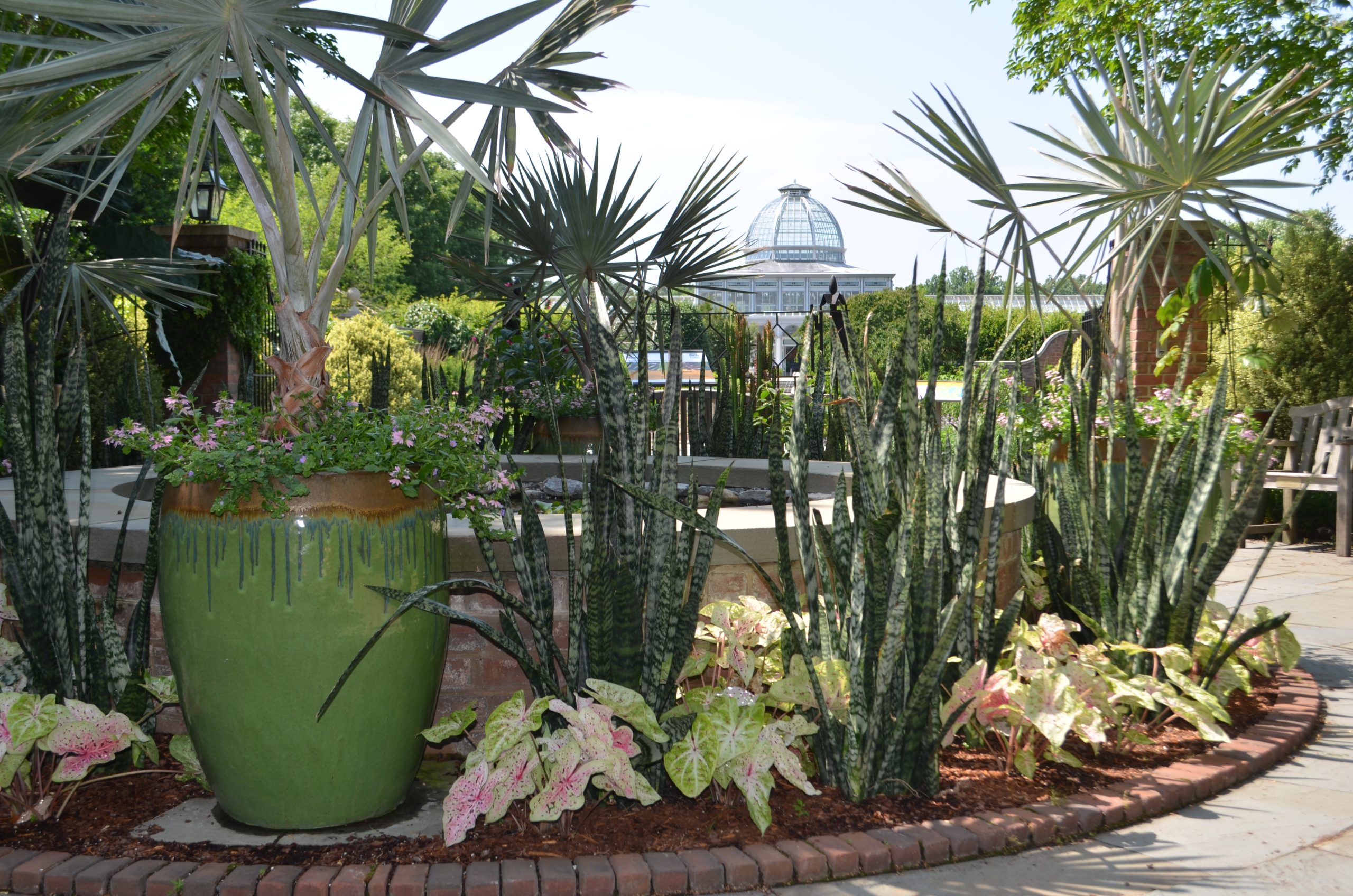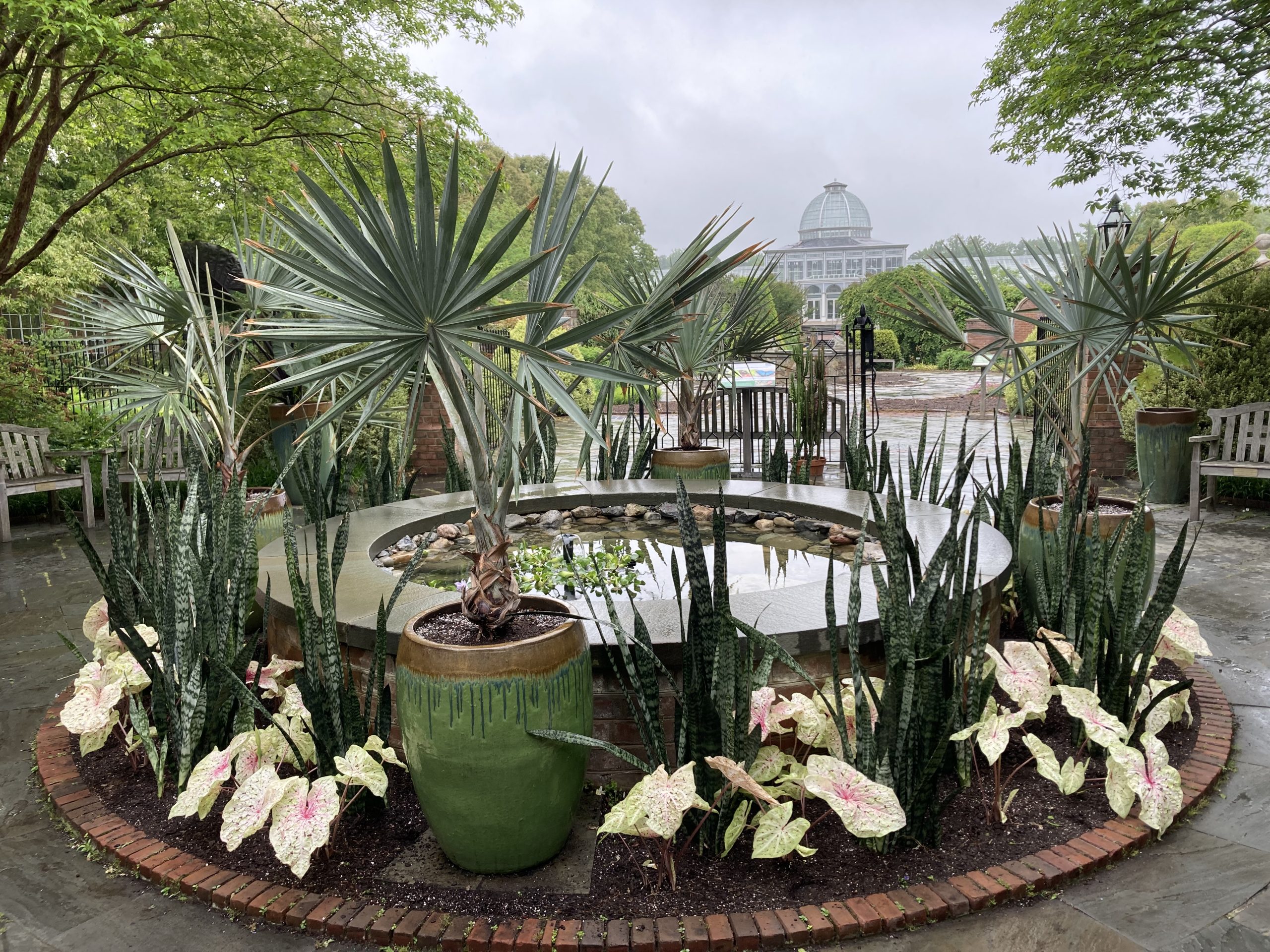The Versatility of Snake Plants
Snake plants, sometimes called “mother-law’s-tongue,” are fascinating plants that thrive easily both indoors and out. Also, they make quite an impression! This summer, Senior Horticulturist Dean Dietrich planted a cultivar of snake plant, (Dracaena trifasciata) ‘Black Coral,’ as an annual on the North Fountain Terrace outside the Robins Visitor Center. They add so much texture and height to this area and are striking against the background of the Conservatory in the distance. We have noticed more than a few of our visitors exclaim, “Wow!” as they enter the doors to the Garden. Outdoors, the plants are simply stunning, especially in combination with the Bismarckia nobilis palms and elephant ear, Caladium ‘Miss Muffet’.

Dracaena trifasciata line circle the bed of the North Fountain Terrace interspersed with Bismarckia nobilis palms, Caladium ‘Miss Muffet’
Snake plants are most commonly known as houseplants. That’s because they are so easy to take care of and are very difficult to kill from neglect. Because they are vertical and clean-looking, snake plants are very popular for individuals with limited indoor space.
What’s the Appeal?
Growing three feet tall or more, their unique freestanding silhouette makes them extremely eye-catching. Rather than being defeated by the force of gravity that makes many plants droop, the snake plant’s pointed tips defy the norm and shoot straight up towards the sky. Typical variegated snake plant leaves have a striped light and dark green pattern, with a solid yellow border around the exterior of the leaves; however, the leaves of ‘Black Coral’ do not have a yellow border.
Dracaena trifasciata (formerly Sansevieria trifasciata) come in all different sizes and can adapt to many different environments with little maintenance. Native to the rocky, dry, regions of West Africa, snake plants are considered virtually indestructible. Interestingly, NASA’s Clean Air Study found that snake plants are one of the most productive air-purifying plants, as they filter toxins like benzene, formaldehyde, and trichloroethylene, while still taking in carbon dioxide and putting out oxygen.
Tips for Growing & Propagating Snake Plants
Because of their popularity, snake plants are easy to find. Most garden centers and even big box stores carry them. But since one of our favorite gifts is plants from friends, you might consider propagating new plants from leaf cuttings from a “mother plant.” Then, you can give your friends the “children” of your own beloved snake plant. Just put 3-inch-long cuttings in soil (bottom edge down) and wait about three months.
They thrive in moderate to bright direct sunlight as they are native to the desert. Since these plants are native to the desert, plant parents should water them sparingly. Excessive watering is the easiest way to kill a snake plant. Their soil should be completely dry before you water them; they prefer to remain mostly dry. They do enjoy occasional water misting to their leaves and soil, though nothing excessive. Normal household temperature and humidity are fine, but the plants do prefer warmer temperatures.
What to Watch for
Snake plants develop brown tips if placed in overly humid environments. Leaf-blades will stop growing entirely if the tip is broken. Snake plants are mildly toxic to pets and small children, so it is best to keep them on elevated surfaces like table tops or window sills if pets or children are around to keep them out of reach. Though the plants prefer direct sunlight, they can easily adapt to lower light conditions. Be cautious of moving the plants from a shady spot to one of bright sunlight as they will scorch. Though plant parents should keep these points in mind, snake plants are ultimately some of the easiest to keep alive. Make sure to have fun and document the growing process!
